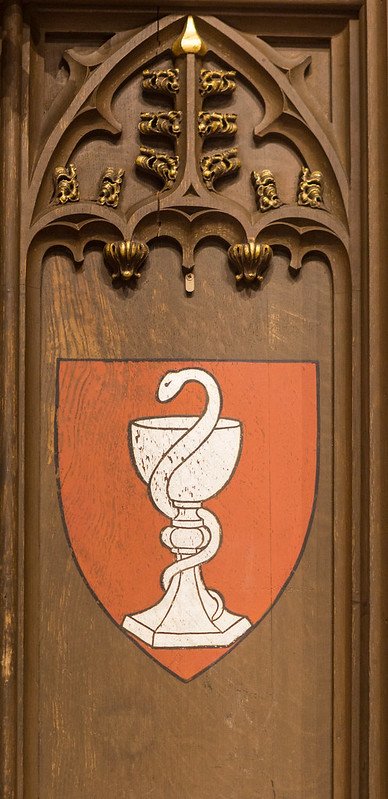St. John the Evangelist - Reredos
The emblem of the cup and the snake represents John the Evangelist. He was also a son of Zebedee and thus James the Great’s brother and the other “Son of Thunder” who threatened the Samaritan village. He is the supposed author of the Gospel of John and presumably the referent to the “beloved disciple.” At the Cross, he stood with Mary, and Jesus charged John to care for Mary after his death (John 19:26-27).
After the resurrection, John the Evangelist traveled throughout Asia Minor, including Ephesus, where he may have been bishop. Because of his strident evangelism, he was persecuted. One tradition holds that the Roman Emperor Domitian had him thrown in a cauldron of boiling oil. John emerged unscathed, so he was exiled to the island of Patmos c. 95 CE, just off the coast of present-day Turkey. It is there or on his return to Ephesus that in addition to the Gospel, some hold he also wrote Johannine Epistles and the Book of Revelation. Most scholars disagree and believe that the Epistles and Revelation were written by another John, John of Patmos, and not by the Evangelist. Regardless, John lived to an old age, the only apostle not martyred. He probably was buried in Ephesus, but no location has been identified and no relics remain.
His emblem of cup and snake has several interpretations. One holds that his enemies plotted to murder him by a poisoned drink, but a vision of a snake warned him away. Alternatively, the cup is the Christian equivalent of the Bowl of Hygeia, the Greek goddess of health, and the daughter of Asclepius, whom we know as the god of medicine. Snakes were common in pagan temple worship, but there is a particular link to medicine. Because snakes slough and replace their skin, they are symbols of healing, rebirth, and immortality. Another theory is that snake venom, while obviously poisonous, could in trace amounts be therapeutic and of benefit to the ill. For either or both of these explanations, to this day the cup and snake is the international symbol of pharmacies.
Dickerman Hollister, Jr., MD
A prayer for further meditation:
Lord Jesus, we honor your disciple St. John the Evangelist,
Chosen at the cross, where love and sorrow coexist.
May our reflections on his sacred duty,
Inspire us to live with compassion and unity.
Amen.

